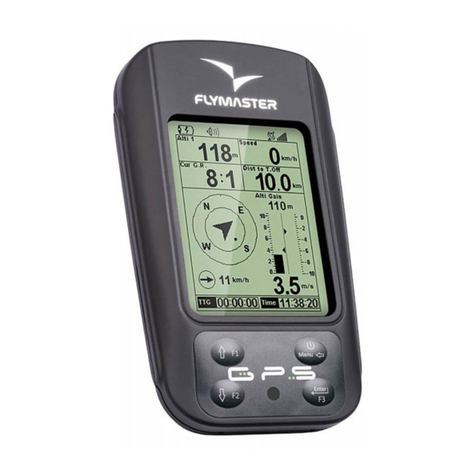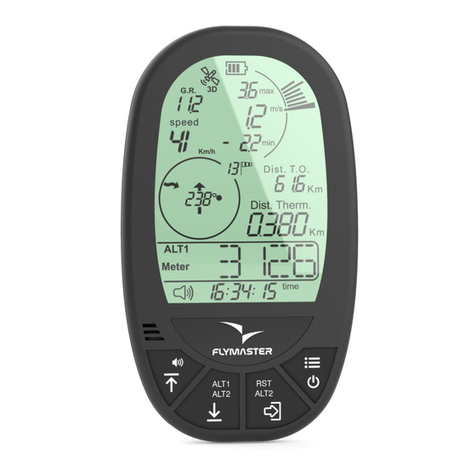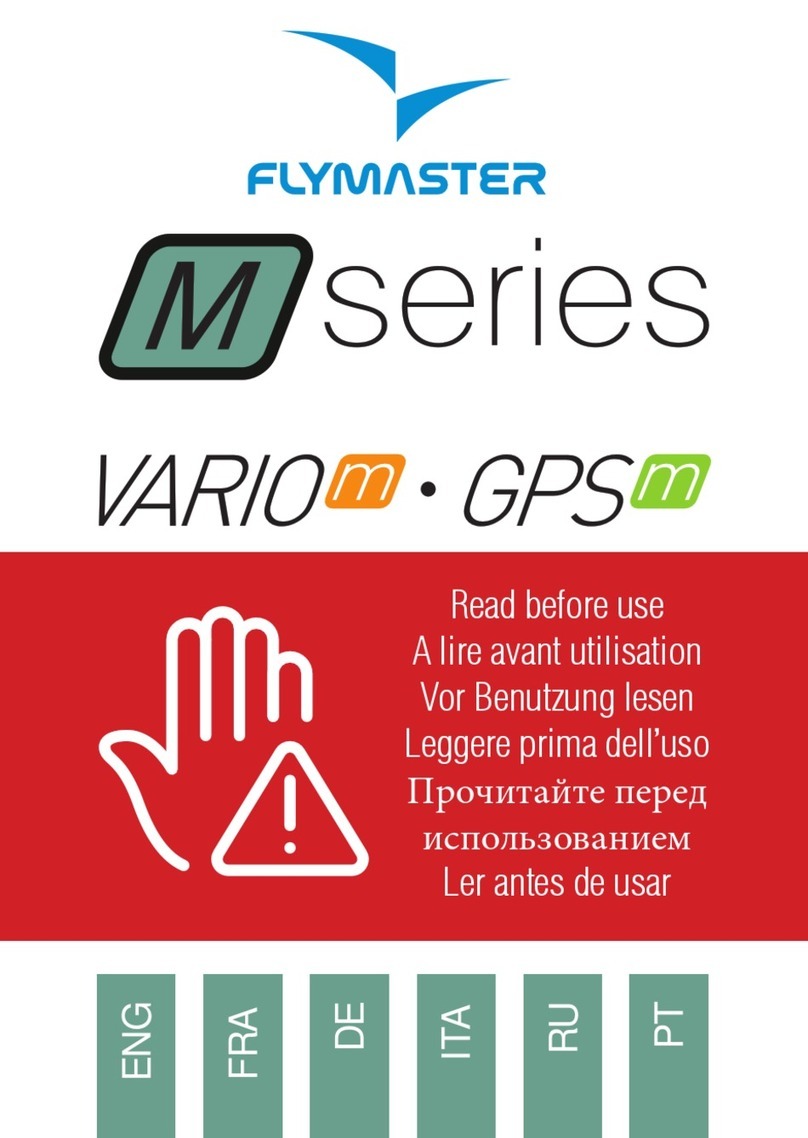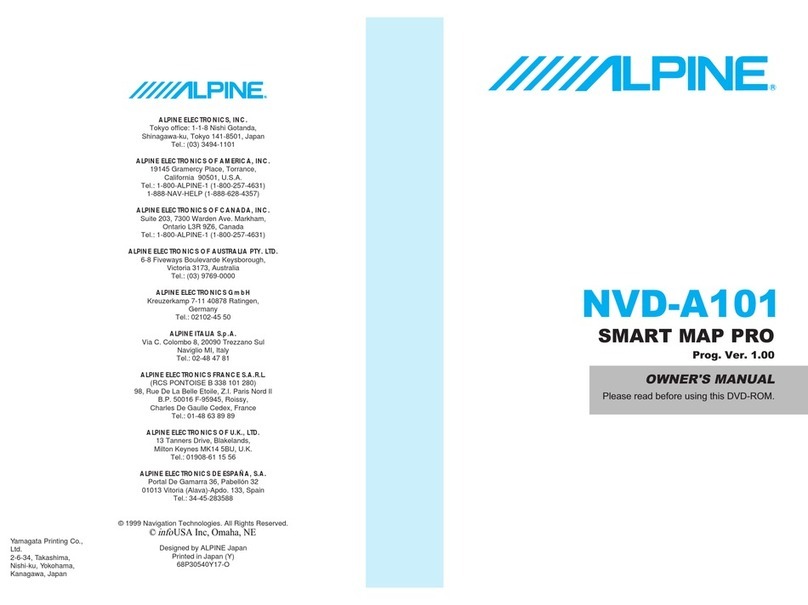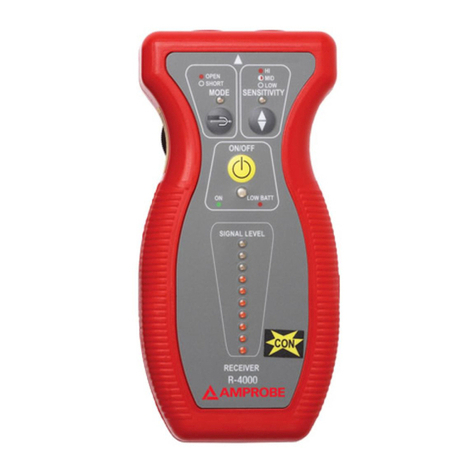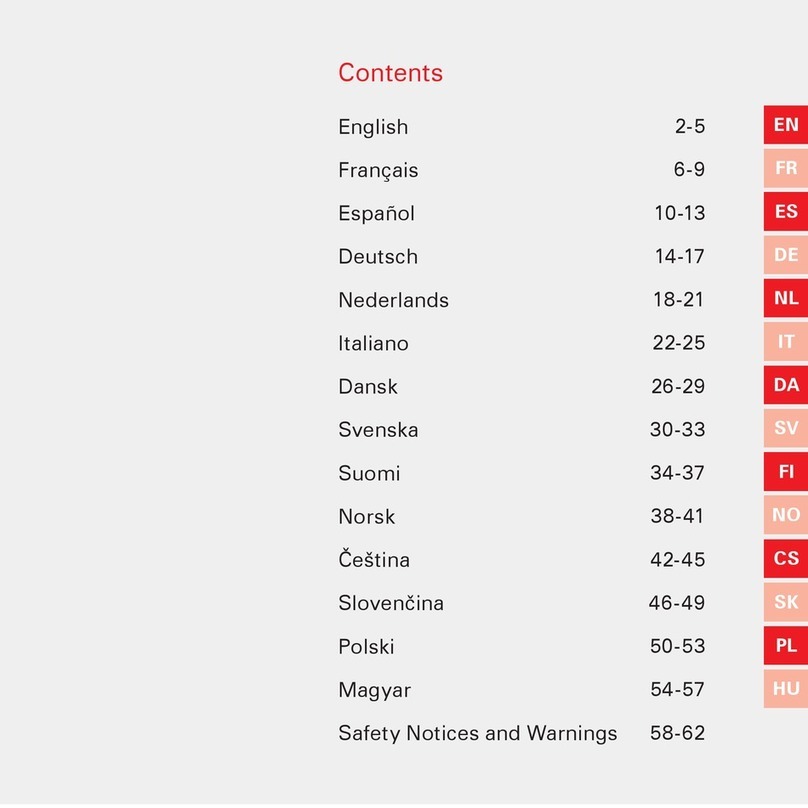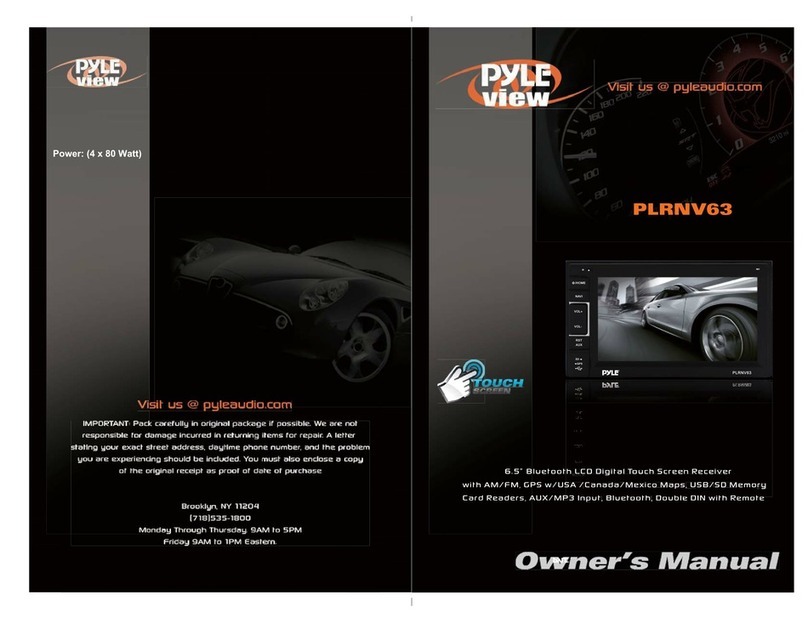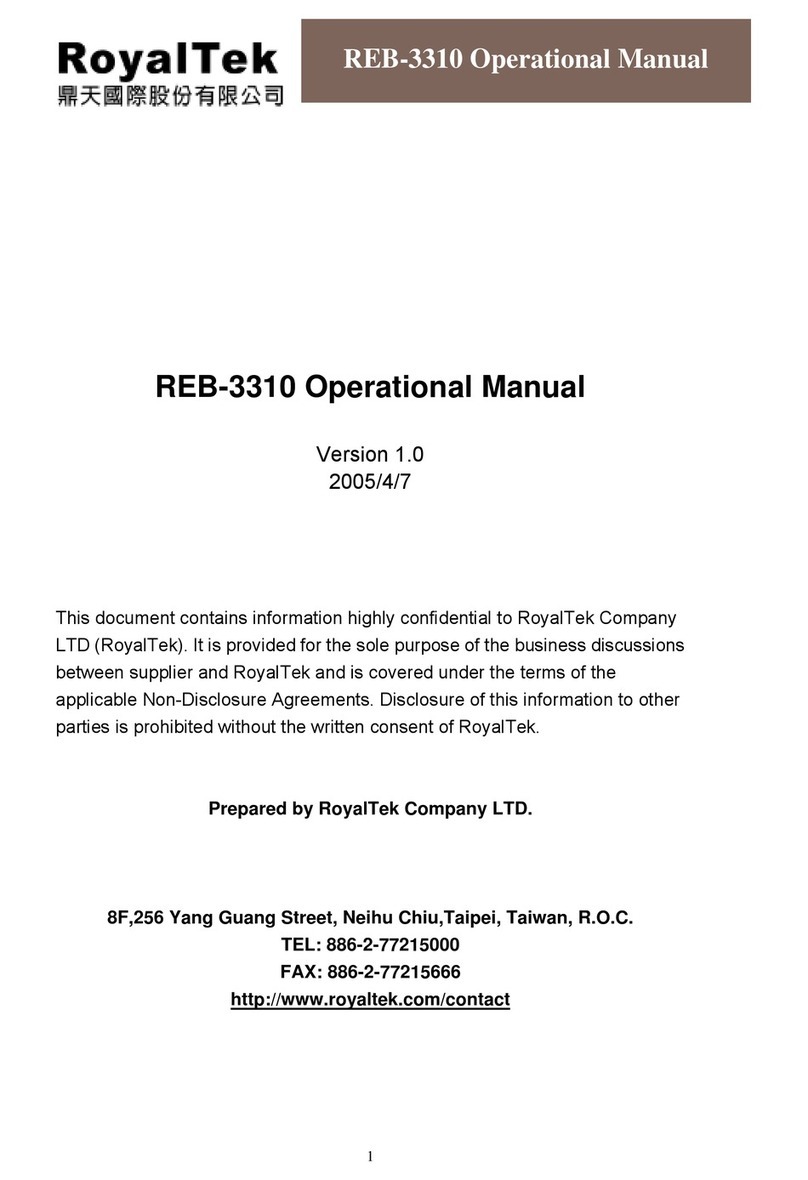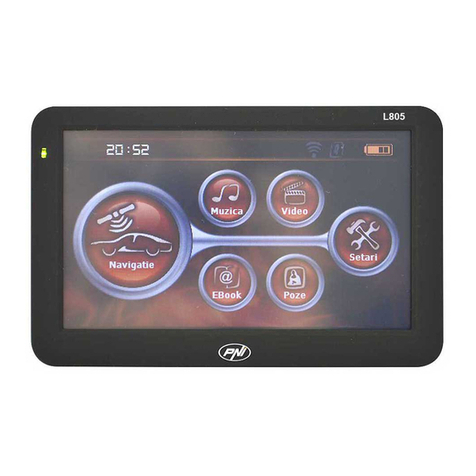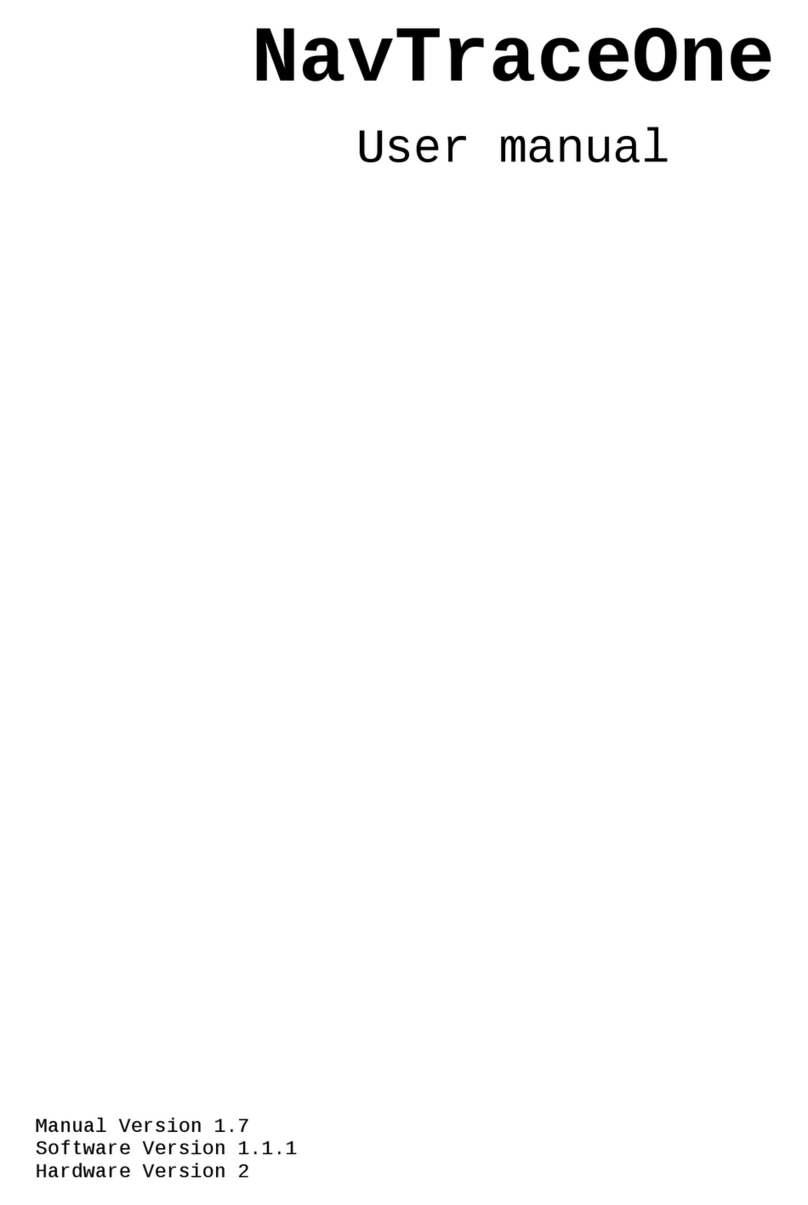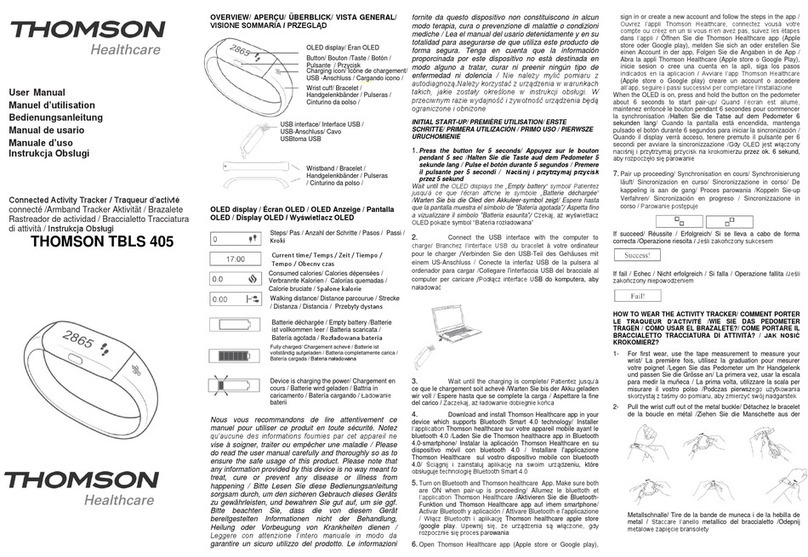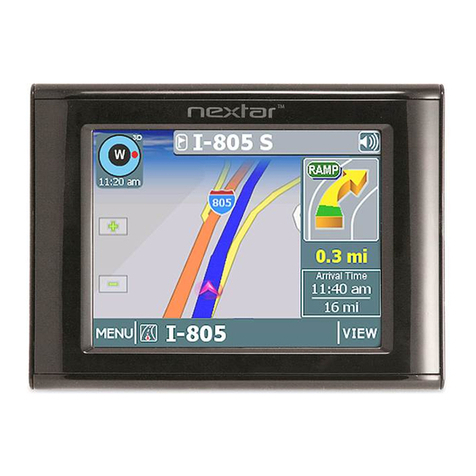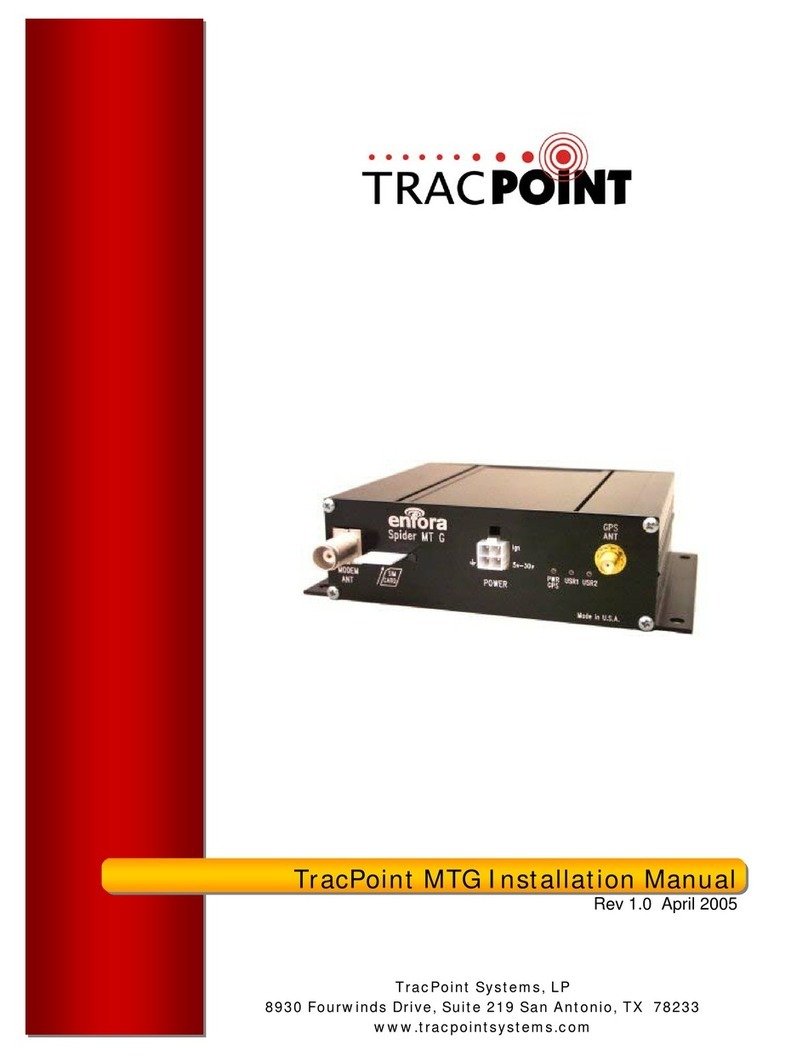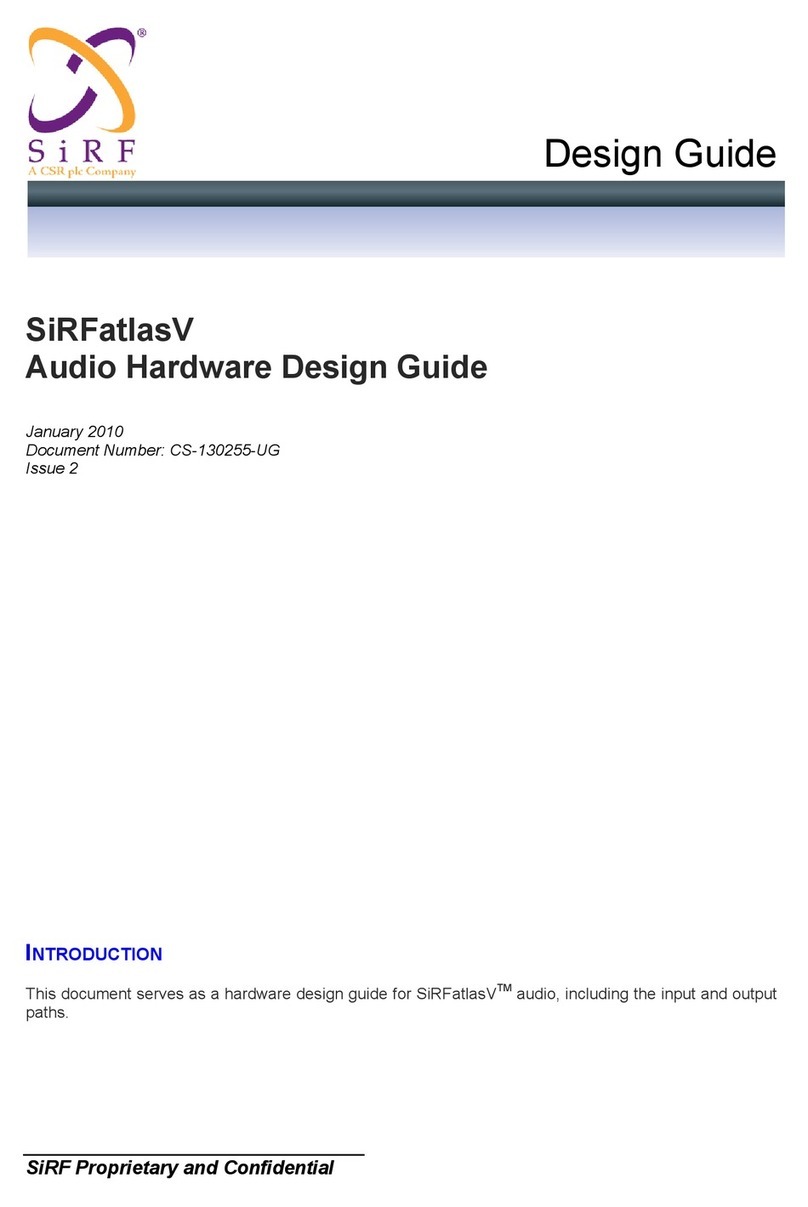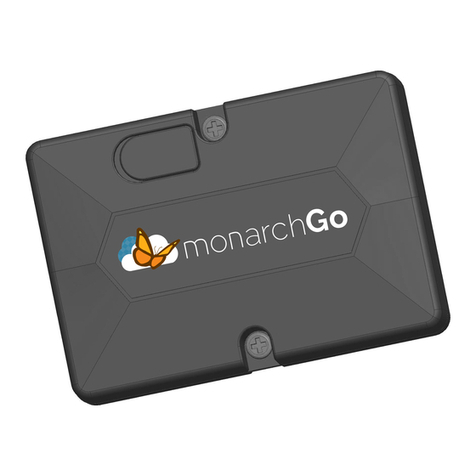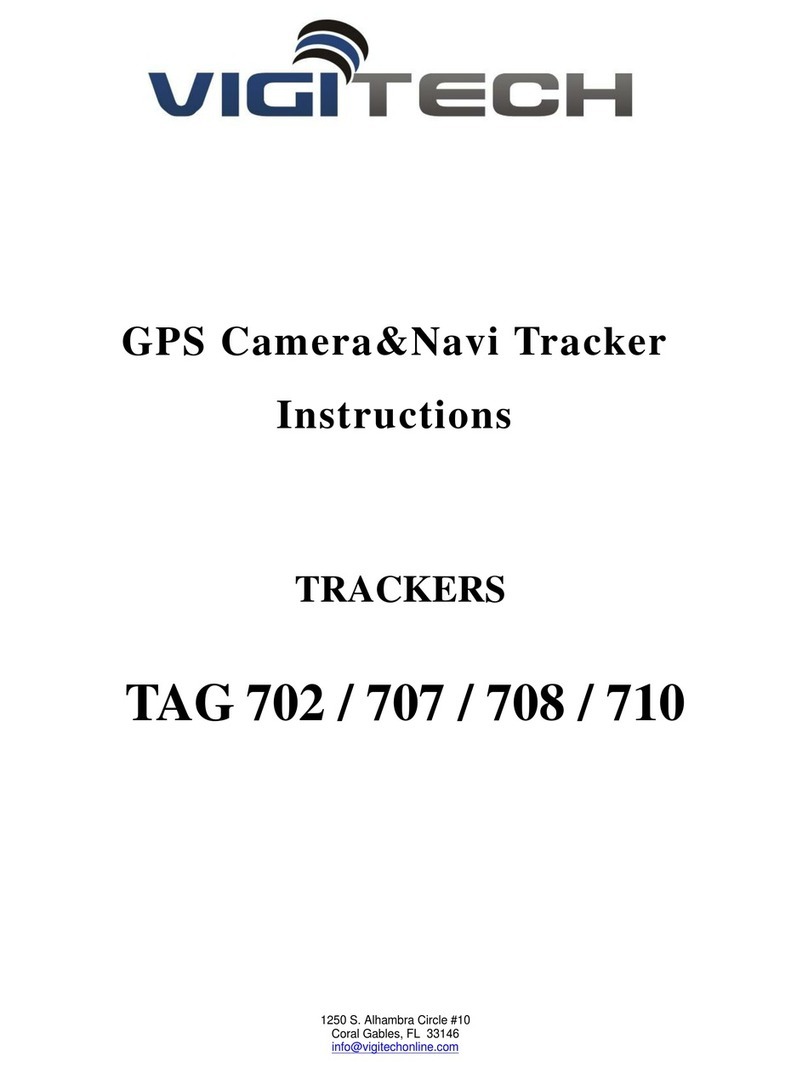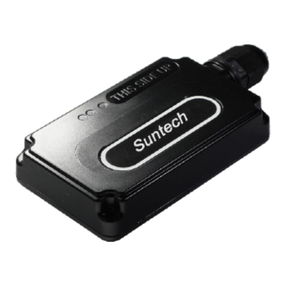Flymaster NAV User manual

User manual
Document version:3.4

..
All rights reserved. Except as expressly provided herein, no part of this manual may be
reproduced, copied, transmitted, disseminated, downloaded or stored in any storage medium,
for any purpose without the express prior written consent of Flymaster Avionics Lda. herein
Flymaster Avionics.
Flymaster Avionics hereby grants permission to download a copy of this manual onto a hard
drive or other electronic storage medium to be viewed and to print a copy of this manual or of
any revision hereto, provided that such electronic or printed copy of this manual must contain the
complete text of this copyright notice and provided further that any unauthorised commercial
distribution of this manual or any revision hereto is strictly prohibited.
Information in this document is subject to change without notice. Flymaster Avionics re-
serves the right to change or improve its products and to make changes in the content without
obligation to notify any person or organisation of such changes or improvements. Visit the
Flymaster Avionics website (www.flymaster-avionics.com) for current updates and supplemental
information concerning the use and operation of this and other Flymaster Avionics products.
Warning It is the sole responsibility of the pilot to operate the aircraft in a safe manner,
maintain full surveillance of all flying conditions at all times, and not become distracted by the
Flymaster NAV . Flymaster Avionics is not responsible for any damages resulting from incorrect
or no data provided by the Flymaster NAV . Flight safety is the sole responsibility of the pilot.
It is unsafe to operate the Flymaster NAV while in the air. Failure by the pilot equipped with
a Flymaster NAV to pay full attention to the aircraft and flying conditions while flying could
result in accident with property damage and/or personal injury.

..
Contents
Page
1 Getting Started 5
1.1 Charging the Battery .................................. 5
1.2 NAV Keys ........................................ 6
1.3 Using keys Inside Menu ................................ 6
1.4 Switching NAV On and Off .............................. 7
1.5 Resetting the NAV .................................. 7
2 Flight Mode 8
3 NAV Elements 10
3.1 Graphical Elements ................................... 10
3.1.1 Battery ..................................... 10
3.1.2 Sound ...................................... 10
3.1.3 GPS ....................................... 11
3.1.4 Vario ...................................... 11
3.1.5 Navigation Circle ................................ 13
3.1.6 Airspaces .................................... 15
3.1.7 Altitude graph ................................. 16
3.1.8 Wind Arrow .................................. 17
3.1.9 Map Page .................................... 18
3.2 Data field Elements ................................... 19
4 Menu mode 23
5 Waypoints and Task 25
5.1 Waypoints Actions Menu ............................... 26
5.1.1 Add Waypoint to Route ............................ 26
5.1.2 Insert New Waypoint ............................. 26
5.1.3 Edit Waypoint ................................. 26
5.1.4 Delete Waypoint ................................ 27
5.1.5 Delete All Waypoints ............................. 27
5.1.6 Go To Point ................................... 27
5.2 Edit Task ........................................ 27
5.2.1 Edit route point ................................ 29
5.2.2 Move Route Point ............................... 30
5.2.3 Remove Route Point .............................. 30
5.2.4 Delete Task ................................... 30
5.2.5 View Task .................................... 30
2

..
5.3 Task Definition ..................................... 31
5.3.1 Setting up the task ............................... 31
6 Task Delay 33
7 Task Navigator 34
8 Critical Airspaces 35
9 Nearby Landings 37
10 Flight Log 38
10.1 Delete Flight ...................................... 39
10.2 Delete All Flights .................................... 39
10.3 Memory capacity .................................... 40
11 GPS status 41
12 Pages 42
13 Settings menu 44
13.1 Set Altimeter ...................................... 44
13.2 Time ........................................... 45
13.2.1 Vario Integrator ................................ 45
13.2.2 Track interval .................................. 45
13.2.3 UTC offset ................................... 46
13.3 Vario Acoustics ..................................... 46
13.3.1 Climb Threshold ................................ 46
13.3.2 Sink Threshold ................................. 46
13.3.3 Sink Alarm ................................... 46
13.3.4 Base Frequency ................................. 46
13.3.5 Increments ................................... 47
13.3.6 Volume ..................................... 47
13.4 Alerts .......................................... 47
13.4.1 Turnpoint Complete .............................. 48
13.4.2 Start Open ................................... 48
13.4.3 Goal Possible .................................. 48
13.4.4 Airspace ..................................... 48
13.5 Advanced Features ................................... 48
13.5.1 Damper ..................................... 48
13.5.2 Cadence ..................................... 48
13.5.3 Dynamic Frequency .............................. 49
13.5.4 Buzzer ...................................... 49
13.5.5 Auto Silent ................................... 51
13.5.6 Start Speed ................................... 51
13.6 Trace ........................................... 51
13.6.1 Enabled ..................................... 51
13.6.2 Auto Zoom ................................... 51
13.6.3 Grey lines .................................... 51
13.6.4 Track up .................................... 51

..
13.7 Screen .......................................... 52
13.7.1 Screen Contrast ................................. 53
13.7.2 Disable Triggers ................................ 53
13.8 Inverse Titles ...................................... 53
13.9 Language/Units ..................................... 54
13.10Device Settings ..................................... 55
13.11RF Probes ........................................ 55
13.12Heart-G ......................................... 56
13.13Data fields ........................................ 56
13.14FS Keys ......................................... 56
13.15Navigation Settings ................................... 57
13.15.1 Safety Margin .................................. 57
13.15.2 Turnpoint Size ................................. 57
13.15.3 Datum ...................................... 57
13.16Airspace settings .................................... 57
14 Firmware 59
15 Interfacing with GPSDump 61
15.1 Configuring GPSDump ................................. 61
15.2 Uploading Waypoints .................................. 62
15.3 Downloading tracklogs ................................. 64
4

..
Chapter 1
Fully charge battery before using your Flymaster for the first time.
Figure 1.1: right view
The battery may be charged by either connecting the NAV USB connector to the wall socket
charger or USB cable. USB connector can be found on the right side of the NAV (see figure 1.1).
1.1 Charging the Battery
Flymaster NAV has an advanced battery power management system, which gives the pilot accurate
information about the battery state, as well as the charging time and battery remaining time.
To charge the Flymaster NAV battery you can use the wall charger, the USB cable, or the car
charger. Original Flymaster accessories are recommended in order to avoid damage to the power
management system.
The Flymaster NAV has 2 charging modes, namely, Quick Charge and Slow charge. The charging
mode choice is automatic and based on the power source. Quick charge mode is activated when
charging with the wall charger or the car charger, while Slow Charge mode is activated when a USB
cable connected to a PC or MAC is used.
Charging, and battery status information is shown on both the power up screen and the Shutdown
menu.
When the Flymaster NAV is connected to a power supply (wall charger or via USB cable), even
with the unit off, the instrument will show if it is being Slow or Fast charged. The time remaining
to full charge is also shown. This may not appear immediately a power source is connected since
the instrument requires some time to calculate the remaining charge time required. A Slow charge
is ok for topping up the battery but not for fully charging. Please use the wall or car charger to
fully charge the instrument.
Note: The instrument will not charge when it is turned on and connected to a PC. To
charge the battery from a USB to PC connection the instrument must be turned off.
This behavior is deliberate to prevent overwhelming competition organizer’s download
hubs.
5

..
Note: Charging the instrument with high ambient temperatures should be avoided, this
will cause the battery to overheat which will halt the charging process, and has a can
affect battery health.
1.2 NAV Keys
Four keys are used to interact with NAV (see Figure 1.2). In this manual we will call MENU key
(S1), ENTER key (S2), UP key (S3), and DOWN key (S4). Each key has 2 functions depending
on context, whether the device is in flight mode or in menu mode. Additionally the MENU key is
used to power-up the NAV when it is switched off.
Figure 1.2: NAV keypad
In the flight mode Keys S2, S3 and S4 have user configurable functions F1, F2 and F3 that can
allocated in the Menu->Settings->FS Keys (see Section 13.14). When a map object exists on a
page FS Keys definition will be ignored and S3 and S4 will zoom in and out of the map whilst the
S2 will switch page. In menu mode all keys have fixed functions shown by symbols on the keys
namely S3=Up S4=Down, S2=Enter and S1=Back.
1.3 Using keys Inside Menu
Changing parameters on the NAV can be performed through the menu. Changing a parameter
involves accessing the menu, selecting an option, and then changing a specific field value. Accessing
the main menu can be done by pressing the MENU key in flight mode. Once in the menu, UP(S3),
and DOWN(S4) keys can be used to scroll up and down through the menu options list. Once the
desired option is selected, the option is highlighted, the ENTER(S2) key should be used to access
the option. Depending on the menu option, a new menu options list, or a data fields list appears.
Pressing the MENU(S1) key takes you back. When accessing data fields the associated menu option
becomes grayed and the respective field data item is highlighted. Using the UP and DOWN keys
changes the value on each field. When the correct value appears pushing the ENTER key moves
to the next field, or in same cases to the next character/digit. Conversely, pushing MENU key
moves to the previous field, or to the next character/digit. If the ENTER key is pushed on the last
field all the data in the selection section is stored and control returns to the configuration menu.
Inversely, if the MENU key is pushed on the first data field the changed settings are ignored and
control is returned to the configuration menu. When setting a data field that involves setting several
characters, e.g. when defining a waypoint name, after defining the desired characters, then pushing
the ENTER key continually for more than 2 seconds will make the cursor jump to the next data
field, or return to the configuration menu if no more data field needs to be set.
6

..
1.4 Switching NAV On and Off
To switch on the NAV , briefly push the S1 key (Menu Key). This will display the start up screen
with a 10 second countdown . Pushing the S2 (Enter key) before the 10 seconds have elapsed will
power up the NAV . The NAV initiates in flight mode. If the S2 key is not pushed within 10 seconds
the NAV will go back to sleep. To switch off the NAV , push the S1(menu key) to activate menu
mode, using the arrow keys (S3 or S4) scroll the cursor to the Shutdown item and push the S2(Enter
Key).
1.5 Resetting the NAV
The reset procedure allows the pilot to restart the NAV in the unlikely event that it freezes, or stops
responding, should this ever occur please report it to our support email. To reset the NAV push S1
(Menu key) and the S4 (Down arrow key) keys simultaneously for at least two seconds. Note that
the S1 and S4 must be pushed at exactly the same time.
7

..
Chapter 2
Flight Mode
The Flymaster NAV has two main working modes, namely Flight mode, and Menu mode. Flight
mode is used during flight, and this allows the user to see information such as Altitude, Speed,
or Vario. The NAV can have up to 16 different pages (see Figure 2.1) in memory. Each page
corresponds to a different screen, which can be completely configured by the user. A set of 16 pages
is called a Layout. Once a Layout containing multiple pages has been defined, the user can switch
page using one of the configurable function keys (see Section 13.14) in Flight Mode.
Figure 2.1: Layout page examples
Screen layout can be configured by the user using a free application, called Flymaster Designer
which can be downloaded from the Flymaster website (www.flymaster.net). This intuitive tool
allows the user to create an unlimited number of layouts, which can be saved to the computer,
uploaded to the instrument, and even shared with other Flymaster users. See the Designer user
manual, available on the website for more information about the Designer tool.
8

..
Designing a Layout consists of inserting a set of objects, called Elements, in the desired position,
and with the desired dimensions, in each of the available 16 pages. The Designer works by what
you see is what you get. This means that when you insert a element in a page, and after uploading
the layout to the instrument, you will see exactly the same thing on the NAV screen.
There are several elements available for the NAV which are presented in the following section.
9

..
Chapter 3
NAV Elements
The main objective of an element is to provide information to the user. Elements can be Graphical,
or Data Field type. Each element has its own properties which can be changed in order to alter the
element behaviour, and/or shape.
3.1 Graphical Elements
Graphical elements are characterized by providing information in a graphical way. Most of the
graphical elements have fixed dimensions, although their position can be altered.
As the NAV firmware evolves the list of Graphical Elements will likely grow. The current list
includes the following graphical elements.
3.1.1 Battery
The Battery Element provides a graphical indication of the current battery level. In Table 3.1 it is
possible to see the relationship between what is shown and the actual battery level in percentage.
This element has fixed dimensions.
Table 3.1: Battery Element description
Symbol Description
Battery level above 90%
Battery level between 70% and 89%
Battery level between 50% and 69%
Battery level between 30% and 49%
Battery level between 15% and 29%
Less than 15% battery remaining
3.1.2 Sound
The Sound Element provides graphical representation on the current volume level. Table 3.2 Shows
the relationship between what is shown and the sound level. This element has fixed dimensions.
10

..
Table 3.2: Sound Element description
Symbol Description
Sound Level 6 (maximum sound level)
Sound Level 5
Sound Level 4
Sound Level 3
Sound Level 2
Sound Level 1
Sound is muted (No sound)
3.1.3 GPS
The GPS Element provides graphical indication about the current GPS signal quality. Basically,
the lower the PDOP value (position dilution of precision), the more accurate calculations are for
determining position . Values bellow 3,0 are fairly accurate. The relationship between what is
shown and the signal quality can be seen in Table 3.3. Note that FAI rules require 3D tracklog
Table 3.3: GPS signal quality
Symbol Description
3D position with a PDOP bellow 1.5
3D position with a PDOP between than 1.5 and 2.0
3D position with a PDOP between than 2.0 and 3.0
3D position with a PDOP greater than 3.0
2D position (no altitude information)
No GPS Signal
data, which includes GPS altitude. Therefore the NAV will only start recording a tracklog when
3D information is available. The NAV has an high sensitivity 50 channel GPS receiver which
offers unmatched tracking performance in harsh signal environments (-160 dBm sensitivity), and
very short acquisition times. The NAV has a 4 Hz GPS update rate (most of others only provide
1Hz) which allows the NAV pilot to see very small speed and position changes. Furthermore, the
movement of the direction arrow is smoother and any position change is shown in a quarter of
the time of other devices. Note that the 4 Hz update rate requires more than 5 satellites in view.
More information about GPS accuracy and also other GPS related information can be seen in
(http://www.kowoma.de/en/gps/errors.htm).
3.1.4 Vario
The Analog Vario Elements shows information regarding the analogue instantaneous vertical speed.
There are four different Elements that can be used to display the vario. All of these element can be
resized and re-positioned.
Analog Vario
This Element which can be resized and repositioned, graphically represents the rate of climb, scaled
from 0 m/s to +/-10 m/s depending if you are climbing or sinking Figure 3.1.
11

..
Figure 3.1: Analog Vario
When the NAV detects that the pilot is climbing, a black bar starts to grow on the left, from
the bottom of the scale to the top ,with 0,1 m/s increments. The same bar grows on the right, from
the top of the scale to the bottom, if sinking is detected.
Big Analog Vario
The Big analog Vario element shows the instantaneous vertical speed (Figure 3.2). This element
can be resized and re-positioned.
Figure 3.2: Big Analog Vario
This Element graphically represents the rate of climb, scaled from 0 m/s to +/-10 m/s depending
if you are climbing or sinking. In this Element a black bar starts from the middle of the scale and
grows at 0.1 m/s increments, up to 5 m/s at the top of the scale. When 5 m/s value is reached the
black bar starts to disappear from 0 m/s (middle of the scale) until the top of the scale. When the
bar completely disappears the climbing rate is equal, or above 10 m/s. The same process occurs
when descending, but from the middle of the scale to the bottom.
Double Bar Analog Vario
The Double Bar Analog Vario element shows the instantaneous vertical speed (Figure 3.3). This
element can be resized and re-positioned. In this Element the left side shows climb rates and the
right side shows sink rates.
12

..
Figure 3.3: Double Bar Vario
Dial Analog Vario
The Dial Analogue Vario element shows the instantaneous vertical speed (Figure 3.4). This element
can be resized and re-positioned. Climb or sink rates are shown by the position of the needle on the
analogue dial. The maximum and minimum climb rates can be set using the DESIGNER software.
Figure 3.4: Dial Vario
3.1.5 Navigation Circle
The Navigation Element is a multi-information element which shows graphically the bearing, wind
direction and thermal core. Additionally, if a destination was defined (waypoint) the navigation
element will also indicates the direction to the waypoint center, the waypoint edge and the direction
to the waypoint after the next one. This element cannot be resized but can be re-positioned.
For navigation information to be displayed the NAV must have a valid GPS fix.
Figure 3.5: Navigation Element
Navigation information is shown within the inner most circles. The external circle contains the
cardinal points. The current traveling direction (bearing) corresponds to the point indicated in the
top of the navigation circle. On the example shown in Figure 3.5, the bearing is approximately
260º.
Navigation Arrows
When a route is active the direction of next optimal point is pointed by an arrow(larger arrow). The
optimal point corresponds to the unique point on the waypoint cylinder which lies along the optimal
route (red route in the Figure 3.6 example). If no route is defined the arrow will start showing the
direction to the takeoff, after the takeoff is detected, i.e. the average speed exceeds 5km/h.
13

..
During a competition task flight using the optimal tangent navigation saves a substantial amount
of time. The smaller arrow closer to the centre of the navigation wheel points to the centre of next
waypoint cylinder, and the arrow furthest away from the centre of the navigation wheel points to
the optimised edge of the waypoint after the next one. The combination of all three arrows provides
a spatial location of the waypoint.
Figure 3.6: Route Optimisation
The example in Figure 3.6 shows a hypothetical task. A pilot navigating to the centre of the
waypoint (following the small arrow) will probably be flying the blue course, whilst a pilot using
the optimised route (red course) will fly the substantially shorter red route. The direction to the
waypoint after the next one is shown by a small arrow on the outer part of the navigation wheel.
In the example in Figure 3.6 this arrow is pointing along the green line, which shows the direction
to WP2, even though WP1 has not been reached.
Small course corrections are sometimes required and these are shown on the NAV by a fine
adjustment indicator in the form of a third small arrow.
An arrow to the left means the pilot should turn slightly to the left, and inversely an arrow to
the right indicates a small adjustment to the right is needed. In the example of Figure 3.6 a very
small arrow pointing to right indicates that the pilot should turn right slightly.
When the course is perfect, i.e. less than 1ºoff, the NAV indicates this by showing a large arrow
forward (Figure 3.7).
Figure 3.7: Perfect Heading
Note that, a start is automatically validated when a pilot correctly completes the start. Until
the start is valid the NAV will not advance to the next point in the route. Another important
aspect of the start is that the NAV does not point to the start cylinder but rather to the next turn
14

..
point on the list. The distance to the start will become highlighted when the pilot is in an irregular
position, i.e. inside a start cylinder where he should be out or vice-versa.
Thermal Core Map
Another useful feature of the Navigation Circle Element is the thermal core map. This map corre-
sponds to a black dot which is shown inside the inner navigation wheel (together with the navigation
arrows).During a thermal climb the NAV keeps track of the strongest climb values point for each
50m layer. The point of strongest lift is then graphically represented by the black ball in the inner
Navigation Circle, showing where the thermal core is relative to the pilot’s position. The position
of the dot (thermal core) is constantly updated as the pilot moves. When the pilot is over 300m
from the thermal core the dot will be at the edge of the circle. As the pilot moves closer to the
thermal core the dot will move towards the center.
Figure 3.8: Thermap Core Map
In Figure 3.8 the thermal core is currently behind the pilot at a distance of approximately 150
meters (half of 300 m wheel radius).
3.1.6 Airspaces
The airspace element provides information to the user relative to specific three-dimensional objects
of the atmosphere, previously loaded to the instrument. Each of this objects can be an airspace
area. Airspace information can loaded to the instrument using the Flymaster Designer software (see
Designer user manual for more information). The NAV only accepts data in the ?OpenAir? format,
and it has a limitation of 3000 polygons points. (See http://www.gdal.org/ogr/drv_openair.html
for more information about the open air format).
Figure 3.9: Airspace Element
When the element of Figure 3.9 is inserted in a layout using DESIGNER, a 2D map (box) is
shown on the instrument. On the bottom left of the map the scale is indicated in Km, and on the
centre of the map is an arrow (see Figure 3.10). This arrow represents the pilot position, and its
orientation indicates the bearing of the movement. The map has always a North Up orientation.
The first time the map is drawn, it is centred on the last GPS position the NAV has in its memory.
The map is re-centred once the flight starts i.e. when a valid gps signal exists, and the start speed
(see Section 13.5.6) is reached.
Once the flight starts, the map is redrawn with an arrow (representing the pilot) which will
move around the map, indicating the relative position of the pilot to each of the airspace areas. If
15

..
the pilot is outside a visible airspace area then a gray line is used to draw the area, whereas if the
pilot is inside the airspace then a black line is used instead. Note that being inside a airspace area
(2D) does not mean that the airspace is being violated, since the pilot can be above, or below the
defined 3D shape. In order to have more information about possible airspace?s violation, some data
fields should be added to the layout. This data fields are Distance to CTR, Altitude to CTR, and
CTR Status (Figure 3.10).
The Dist. CTR data field shows the shortest horizontal distance to the nearest airspace line.
This distance is always positive. Similarly, the Alt. To CTR shows the shortest vertical distance
to nearest airspace line. Unlike the horizontal distance, the vertical distance can be negative. A
positive vertical distance indicates that you are outside the airspace, whereas a negative distance
indicates that you are inside the airspace. Additionally, the CTR status field will indicate if an
airspace is being violated by displaying Violating. If the pilot is not violating the airspace but it
is inside a predefined margin then the messages Altitude Imminent, or Position Imminent will be
shown.
Figure 3.10: Airspace Map and Associated Data Fields
When the page contains an airspace map element, the UP, and DOWN keys, can be used to
change the map scale: pressing the UP key will decrease the scale, and the DOWN key will increase
the scale.
3.1.7 Altitude graph
The Altitude graph element (Figure 3.11) corresponds to a graph of altitude versus time. Altitude
is shown in the vertical axis graduated in meters with time shown on the horizontal axis graduated
in seconds.
Figure 3.11: Altitude Graph Element
The range of the horizontal axis is fixed and corresponds to 240 seconds (4 minutes), while the
16

..
range of the vertical axis is automatically adjusted in order to accommodate the gained height. In
reality the altitude graph element is a plot of the absolute altitude over the last 4 minutes of flight
(Figure 3.12).
Figure 3.12: Altitude Plot
3.1.8 Wind Arrow
The Wind Arrow element (Figure 3.13) is a re-sizable graphical element.
Figure 3.13: Wind Arrow Element
When used in a layout an arrow is draw showing the wind direction relative to the pilot direction
(direction the wind is coming FROM). For example, if the pilot is facing the wind then the arrow
points south (bottom of the screen). Centered over the arrow is a circle in which a number is
displayed showing the wind speed in Km/h (Figure 3.14). The wind speed value can be also seen
in a data field.
Figure 3.14: Wind Arrow
Note that both wind direction, and speed, are calculated based on the GPS ground speed while
the pilot is turning, so there is no need of wind speed probe.
17

..
3.1.9 Map Page
The MAP element (Figure 3.15) provides information to the user about their position relative to
waypoints, cylinder edges and the pilot’s trace or track. This element can be resized and moved
around the screen.
Figure 3.15: Map Element
A typical map page in flight may look like Figure. 20. In this figure is shown the scale on the
bottom left. The scale can be manually changed by pressing the F1 button to enlarge the map
and therefore reduce the scale, and conversely by pressing the F2 button to reduce the map and
therefore increase the scale.
Figure 3.16: Map Page
If flying a competition route, the optimized route is drawn between the turnpoint cylinders. The
position of the pilot is indicated by the arrow and the trace for the last approximately 4 mins of
the flight is shown. Traces older than 4 mins are erased to reduce clutter on the screen.
18

..
3.2 Data field Elements
Data field elements can be used to shown numerical information like altitude, vertical speed, speed,
glide ratio, and many others.
These elements have configurable size, and position, although the text within has only 3 possible
sizes. Table 6 explains the available data fields. As the NAV firmware evolves this list will likely
grow.
Table 3.4: Data fields Description
Field ID Description
A.OverGoal Altitude over goal is the difference between the current altitude
and the goal’s altitude based on barometric pressure values.
Above Toff Altitude above takeoff is the altitude over the flight starting point.
Abs.Pressure Absolute atmospheric pressure value in Pascals.
Active waypoint Active turnpoint name.
AirTemp. Air Temperature as measured by the wireless speed probe.
Alt.Gain Altitude Gain. Altitude gained in current thermal.
Alt.Gain/Loss Altitude Gain/Loss. When at the top of the thermal displays the
altitude gained from the base of the thermal, else displays the
altitude lost since reaching the top of thermal.
Alt.to CTR Altitude to CTR shows altitude to controller airspace, a negative
number indicates we must sink to come out of controlled airspace.
Altitude Current altitude. This altitude is calculated based on the baro-
metric pressure and depends on the QNH value.
Altitude2 Second Altimeter which can be set independently to the main
altimeter.
Arrival Goal Estimated arrival height above Goal. The height is calculated
considering the average glide ratio that has being made. This
means that wind, day quality and glider performance are used in
the calculations.
Arrival Next Estimated arrival height above the next waypoint. This means
that wind, day quality and glider performance are used in the
calculations.
Ave.Speed Average ground speed calculated using a filter to show a smoothed
speed, eliminating erratic speed changes due to glider pitching,
etc.
Ave.Vario Average Vario calculated using an integration time constant in
order to indicate smoother climbing rates.
AveROT Average rate of turn in degrees per second.
Battery Shows battery strength as a percentage of complete charge
Bearing Current bearing in degrees.
CTR Name Name of the airspace causing warning or violation.
CTR Status Status message of airspace, will show Violating when in controlled
airspace, Immenent Alt when close to entering airspace vertically
or Pos.Immenent when close to entering airspace horizontally.
Cur.G.R. Current glide ratio calculated using the average vario value, and
average ground speed.
Date Current date. This value is automatic set when the device gets a
valid GPS Signal
Continued on next page
19
Table of contents
Other Flymaster GPS manuals
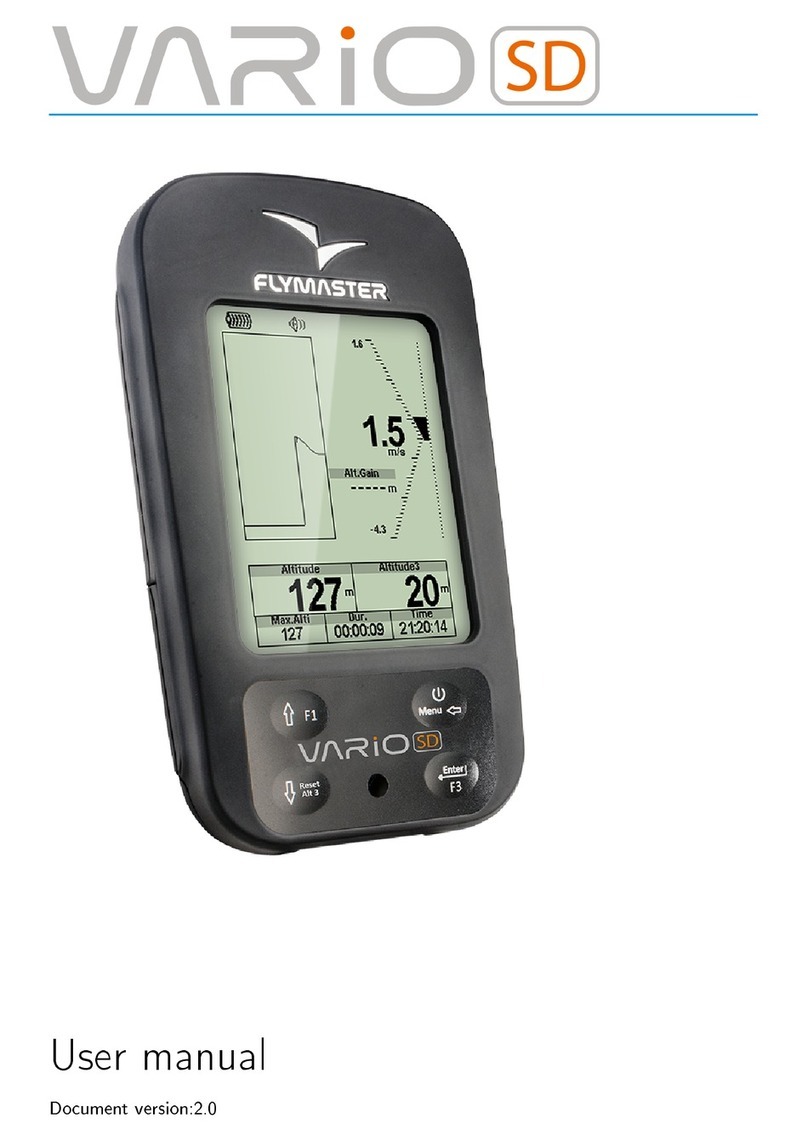
Flymaster
Flymaster Vario SD User manual
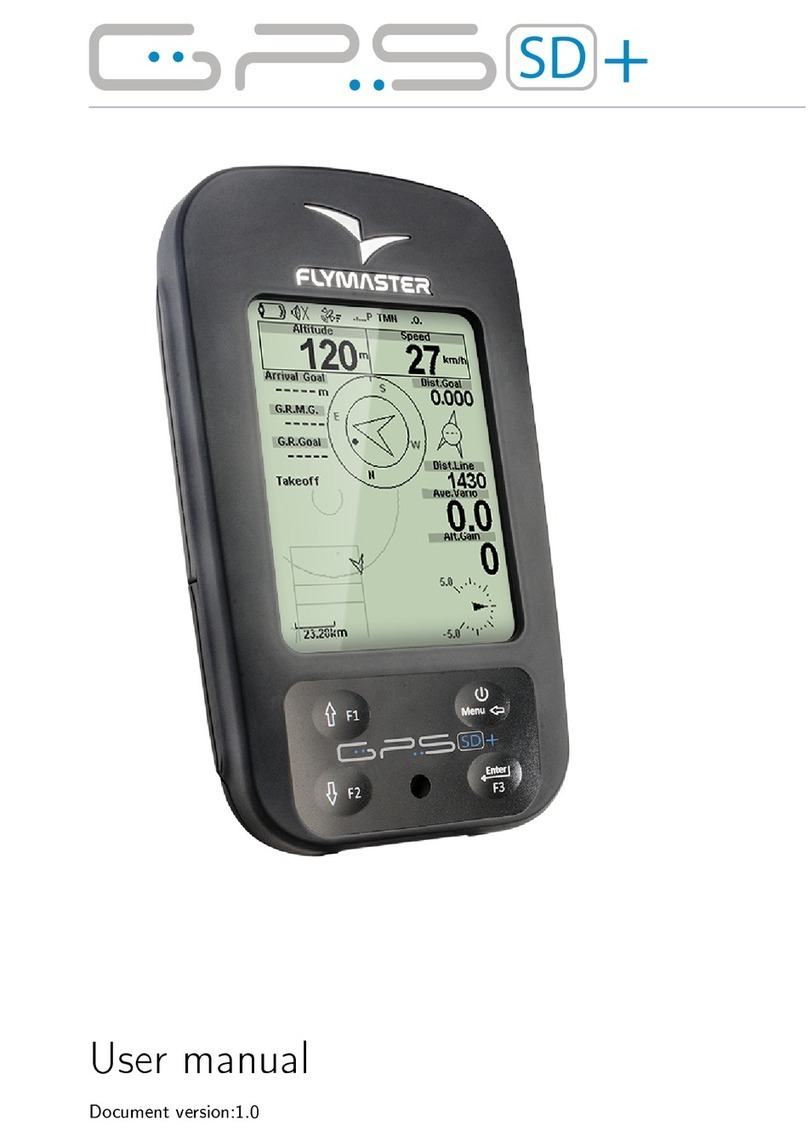
Flymaster
Flymaster SD+ User manual

Flymaster
Flymaster LIVE SD User manual
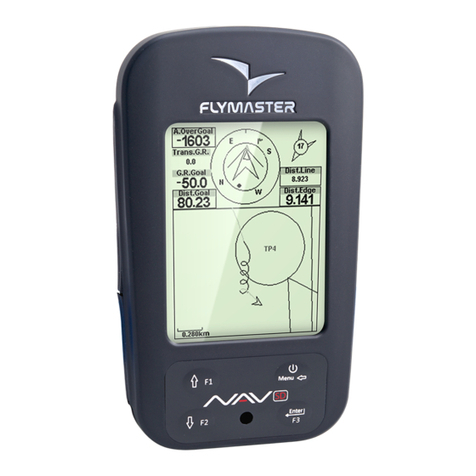
Flymaster
Flymaster Nav SD User manual

Flymaster
Flymaster GPS SD User manual

Flymaster
Flymaster SD Series User manual
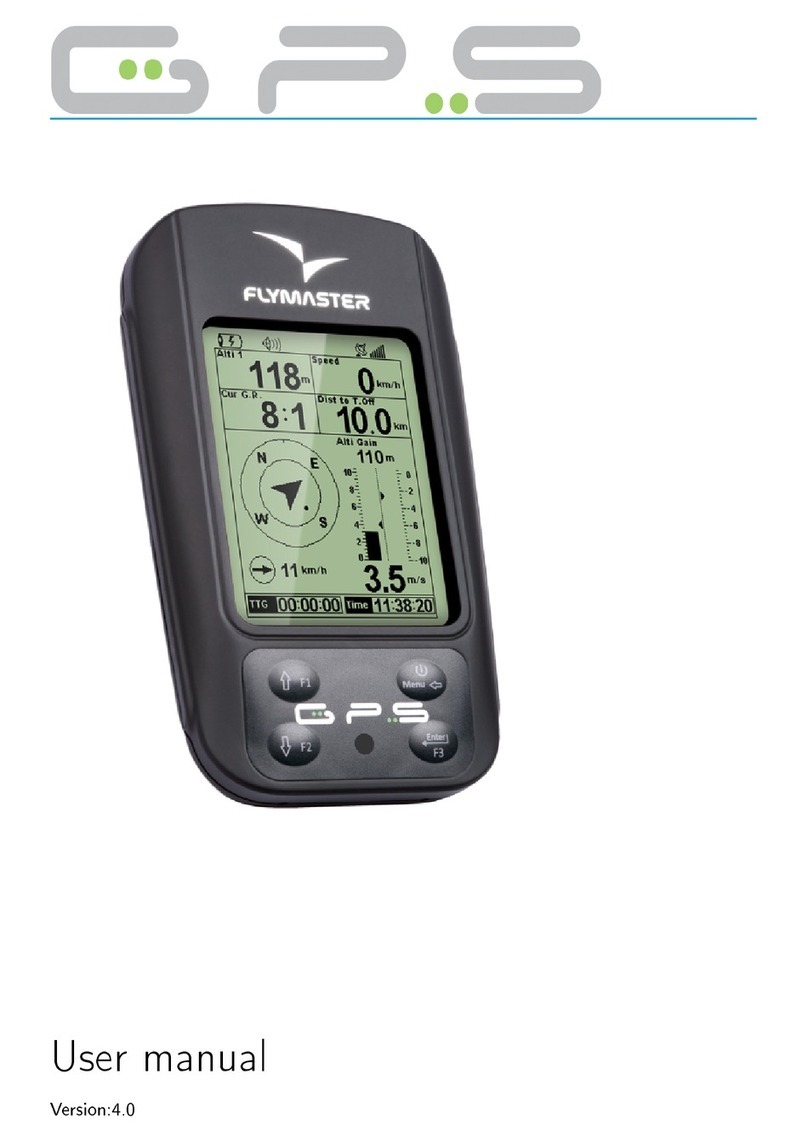
Flymaster
Flymaster GPS User manual
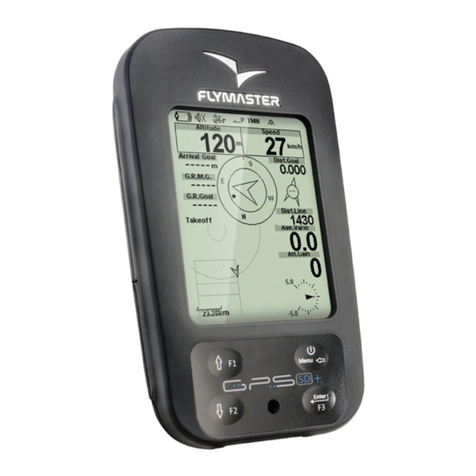
Flymaster
Flymaster LIVE SD User manual
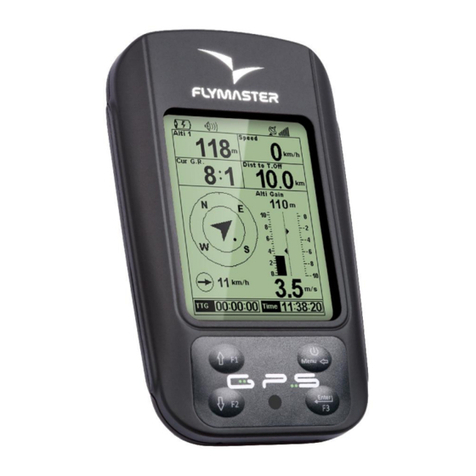
Flymaster
Flymaster GPS Navigator User manual
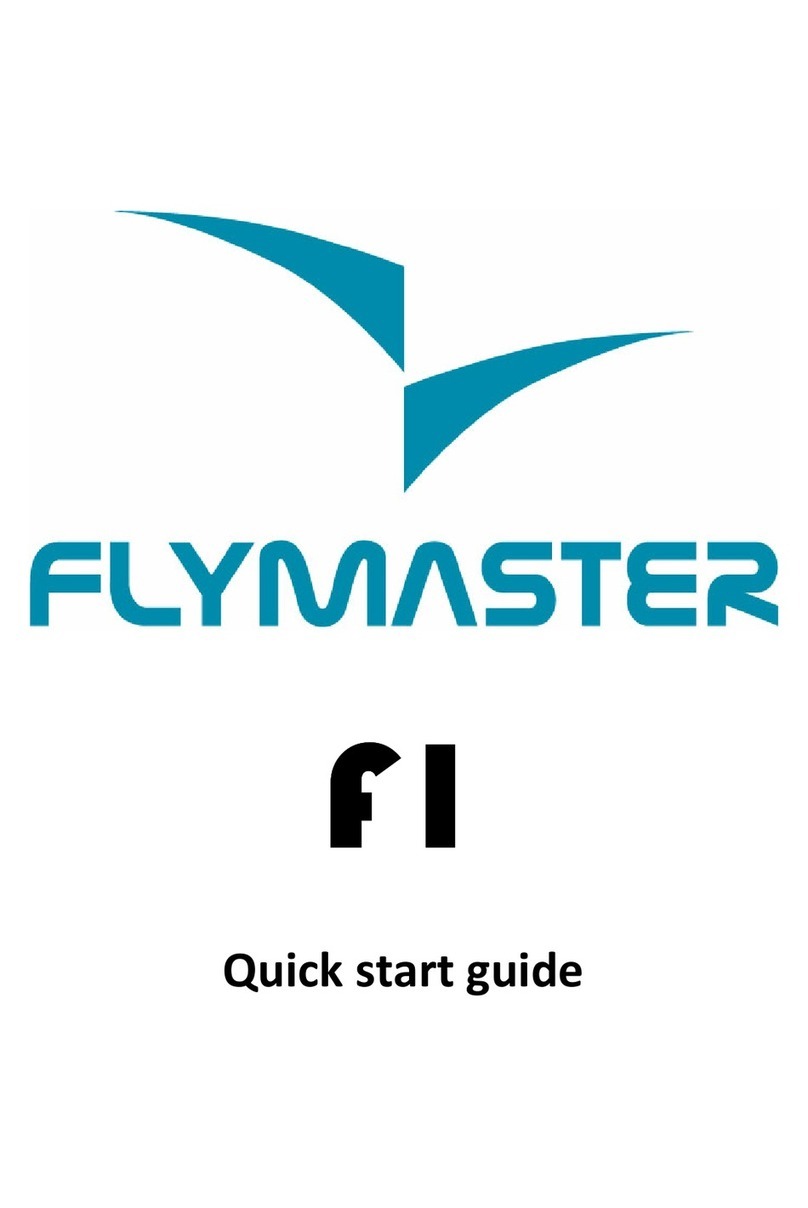
Flymaster
Flymaster F1 User manual

